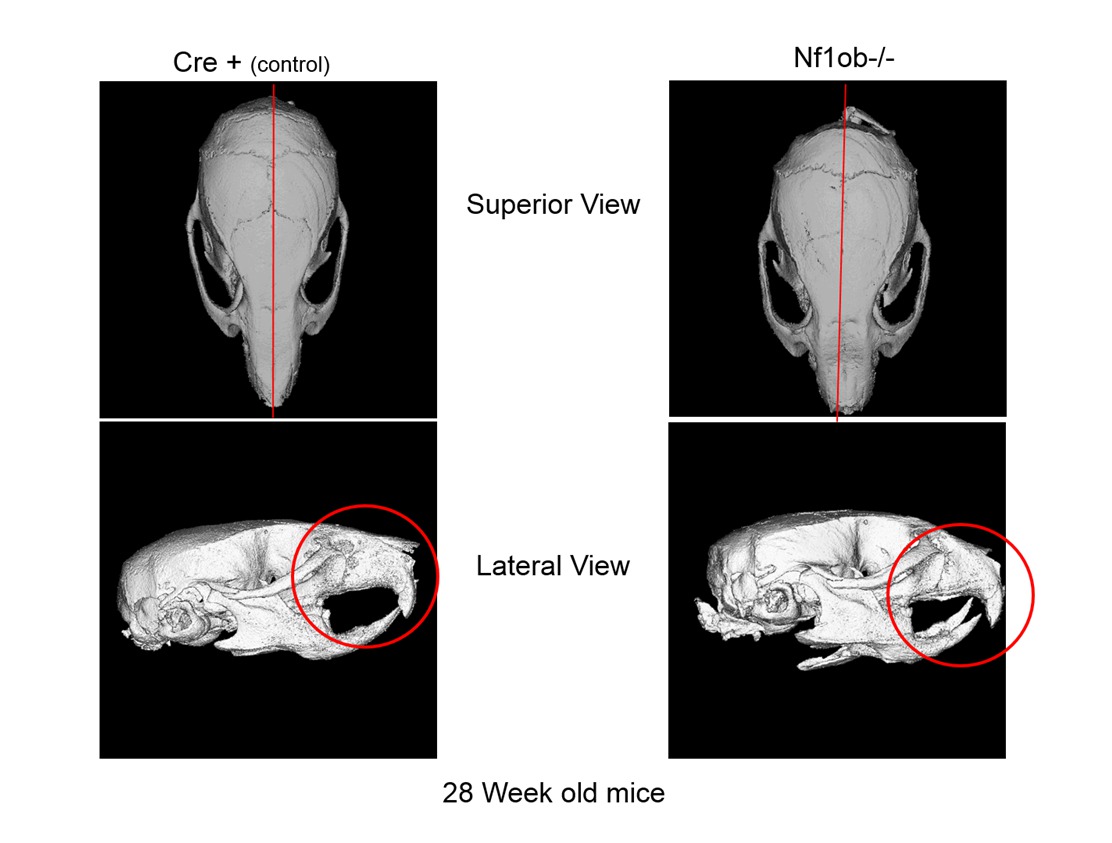IADR Abstract Archives
Craniofacial Deformity and Malocclusion in a Mouse Model of Neurofibromatosis Type 1 (NF1)
Objectives: Neurofibromatosis type I (NF1) is an autosomal dominant disorder that has multiple manifestations, beside neurofibromatosis, such as the presence of café-au-late spots, learning disabilities. A large proportion of NF1 patients display skeletal deformities including alteration in bone size and shape, the presence of scoliosis, and tendency to develop pseudoarthrosis. Craniofacial abnormality occurs in about 7% of NF1 patients and is characterized by hypoplasia or absence of greater wing of sphenoid bone. This dysplasia is progressive and always unilateral, results in proptosis of one eye and mid-facial bone associated with malocclusion, and is termed Sphenoid Wing Dysplasia (SWD). By using an NF1 KO mouse model, we propose to eliminate the possibility of tumor as a cause of facial deformity, to establish an osteoblastic origin for the phenotype by histological examination. Monetering the mice will help to characterize the time course of the progression of craniofacial defect and to identify metrics to follow the progression of the phenotype, and to test the effect of treatment with diet, PTH and Ras antagonist on the development and progression of the phenotype.
Methods: We established a breeding colony of neurofibromin (NF1 gene) osteoblast conditional knockout mice using collagen-I Cre. Mice sacrificed for skull Micro-CT scan and for cell harvest ( osteoblast precursors ). The skulls' images then landmarked using Analyze 10.0 software, and the deformity assessed using The Euclidean Distance Matrix Analysis (EDMA) software and morphometric analysis to compare the changes in landmarks position in control and KO mice skulls.
Results: Results from 12 mice samples ( 8 KO and 4 control) indicate that the NF1ob-/- mice present with cranial asymmetry with eye proptosis and malocclusion as the animal age. Micro-CT of these animals shows a progressive (12-24 weeks) loss of craniofacial symmetry at the sphenoid bone and other cranial bones. This phenotype is strikingly similar to SWD seen in NF1 patients.
Conclusions: Upon completion of the study, we hope to be able to identify the osteoblastic cause of sphenoid wing dysplasia in NF1. Once the cause is known, it will allow us to identfy possible theraputic agents which will help to prevent the development of malocclusion and facial asymmetry in NF1 patients.
Methods: We established a breeding colony of neurofibromin (NF1 gene) osteoblast conditional knockout mice using collagen-I Cre. Mice sacrificed for skull Micro-CT scan and for cell harvest ( osteoblast precursors ). The skulls' images then landmarked using Analyze 10.0 software, and the deformity assessed using The Euclidean Distance Matrix Analysis (EDMA) software and morphometric analysis to compare the changes in landmarks position in control and KO mice skulls.
Results: Results from 12 mice samples ( 8 KO and 4 control) indicate that the NF1ob-/- mice present with cranial asymmetry with eye proptosis and malocclusion as the animal age. Micro-CT of these animals shows a progressive (12-24 weeks) loss of craniofacial symmetry at the sphenoid bone and other cranial bones. This phenotype is strikingly similar to SWD seen in NF1 patients.
Conclusions: Upon completion of the study, we hope to be able to identify the osteoblastic cause of sphenoid wing dysplasia in NF1. Once the cause is known, it will allow us to identfy possible theraputic agents which will help to prevent the development of malocclusion and facial asymmetry in NF1 patients.

